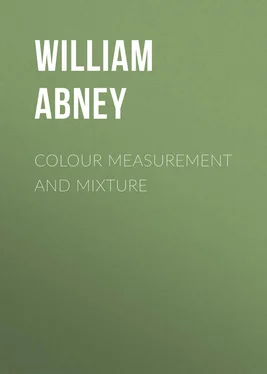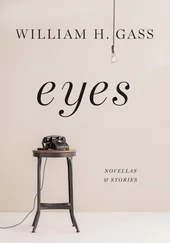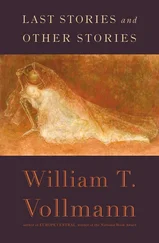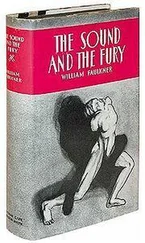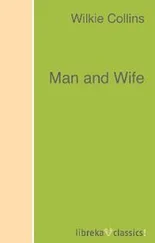William Abney - Colour Measurement and Mixture
Здесь есть возможность читать онлайн «William Abney - Colour Measurement and Mixture» — ознакомительный отрывок электронной книги совершенно бесплатно, а после прочтения отрывка купить полную версию. В некоторых случаях можно слушать аудио, скачать через торрент в формате fb2 и присутствует краткое содержание. Жанр: foreign_antique, foreign_prose, на английском языке. Описание произведения, (предисловие) а так же отзывы посетителей доступны на портале библиотеки ЛибКат.
- Название:Colour Measurement and Mixture
- Автор:
- Жанр:
- Год:неизвестен
- ISBN:нет данных
- Рейтинг книги:3 / 5. Голосов: 1
-
Избранное:Добавить в избранное
- Отзывы:
-
Ваша оценка:
- 60
- 1
- 2
- 3
- 4
- 5
Colour Measurement and Mixture: краткое содержание, описание и аннотация
Предлагаем к чтению аннотацию, описание, краткое содержание или предисловие (зависит от того, что написал сам автор книги «Colour Measurement and Mixture»). Если вы не нашли необходимую информацию о книге — напишите в комментариях, мы постараемся отыскать её.
Colour Measurement and Mixture — читать онлайн ознакомительный отрывок
Ниже представлен текст книги, разбитый по страницам. Система сохранения места последней прочитанной страницы, позволяет с удобством читать онлайн бесплатно книгу «Colour Measurement and Mixture», без необходимости каждый раз заново искать на чём Вы остановились. Поставьте закладку, и сможете в любой момент перейти на страницу, на которой закончили чтение.
Интервал:
Закладка:
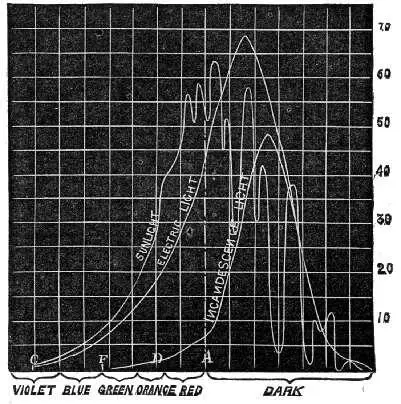
Fig. 5. – Heating effect of different Sources of Radiation.
The above figure is a graphic representation of the heating effect of the spectrum of the electric light, sunlight, and the incandescence electric light, on the lamp-black coating of the thermopile, as shown by the galvanometer. The vast difference between the heating effect of the visible rays of the first two sources compared with the last is clearly indicated.
Since every ray may be taken as totally absorbed, the heating of the lamp-black is a measure of the energy or the capacity of performing work of some description, which they possess. Waves of the sea do work when they beat against the shore, and they do work when they lift a vessel. If we notice a ship at anchor we shall find that behind the vessel and towards the shore the waves are lowered in height or amplitude; the energy which they have expended in raising the vessel of necessity causes this lowering. In the same way the waves of light, after falling on matter whose molecules or atoms are swinging in unison with them, are destroyed, and the energy is spent in either decomposing the matter into a simpler form at first – though the subsequent form may be more complex – or in raising its temperature. As lamp-black or carbon is in its simplest form, the only work done upon it by the energy of radiation is the raising of its temperature, and it is for this reason that this material is so excellent for covering the junctions of the pile. The eye evidently does not absorb all rays, since only a limited part of the spectrum is visible, and it would be useless to take a measure of the heating effect of lamp-black for the visible part of the spectrum as a measure of its luminosity, since the latter fades off in the red – the very place in which the heat curve rises rapidly.
CHAPTER IV
Description of Colour Patch Apparatus – Rotating Sectors – Method of making a Scale for the Spectrum.
Before proceeding further we must describe somewhat in detail two or three pieces of apparatus to be used in the experiments we shall make.
The first piece was devised by the writer a few years ago, and has got rid of several objections which existed in older pieces of apparatus. It is not only useful for lecture purposes, but also for careful laboratory work. The ordinary lecture apparatus for throwing a spectrum on the screen is of too crude a form to be effective for the purpose we have in view; the purity of the colours seen on the screen is more than doubtful, and this alone unfits it for our experiments. If we want to form a pure spectrum we must have a narrow slit, prisms with true, flat surfaces, and lenses of proper curvature. As a rule the ordinary lecture apparatus for forming the spectrum lacks all of these requisites.
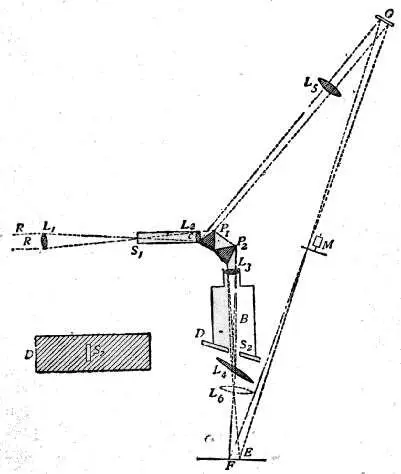
Fig. 6. – Colour Patch Apparatus.
The accompanying diagram (Fig. 6) will give an idea of the apparatus we shall employ. On the usual slit S₁ of a collimator C is thrown, by means of a condensing lens L₁, a beam of light, which emanates from the intensely white-hot carbon positive pole of the electric light. The focus is so adjusted that an image of the crater is formed on the slit. The collimating lens L₂ is filled by this beam, and the rays issue parallel to one another and fall on the prisms P₁ and P₂, which disperse them. The dispersed beam falls on a corrected photographic lens L₃, attached to a camera in the ordinary way. It is of slightly larger diameter than the height of the prisms, and a spectrum is formed on the focusing-screen D, which is slewed at a slight angle with the perpendicular to the axis of the lens L₃. This is necessary, because the focus of the least refrangible or red rays is longer than that of the more refrangible or blue rays. By slewing the focusing-screen as shown, a very good general focus for every ray may be obtained. When the focusing-screen is removed, the rays form a confused patch of parti-coloured light on a white screen F, placed some four feet off the camera. The rays, however, can be collected by a lens L₄, of about two feet focus, placed near the position of the focusing-screen, and slightly askew. This forms an image on the screen of the near surface of the last prism P₂; and if correctly adjusted, the rectangular patch of light should be pure and without any fringes of colour. The card D slides into the grooves which ordinarily take the dark slide. In it will be seen a slit S₂, the utility of which will be explained later on.
We shall usually require a second patch of white light, with which to compare the first patch. Now, although the light from the positive pole of the carbons is uniform in quality, it sometimes varies in quantity, as it is difficult to keep its image always in exactly the centre of the slit. If we can take one part of the light coming through the slit to form the spectrum, and another part to form the second patch of white light, then the brightness of the two will vary together. At first sight this might appear difficult to attain; but advantage is taken of the fact that from the first surface of the first prism P₁ a certain amount of light is reflected. Placing a lens L₅, and a mirror G, in the path of this reflected beam, another square patch of light can be thrown on the same screen as that on which the first is thrown, and this second patch may be made of the same size as the first patch, if the lens L₅ be of suitable focus, and it can be superposed over the first patch if required; or, as is useful in some cases, the two patches may be placed side by side, just touching each other.
We are thus able to secure two square white patches upon the screen F, one from the re-combination of the spectrum, and one from the reflected beam. If a rod be placed in the path of these two beams when they are superposed, each beam will throw a shadow of the rod upon the screen. The shadow cast by the integrated spectrum will be illuminated by the reflected beam, and the shadow cast by the latter will be illuminated by the former. In fact we have an ordinary Rumford photometer, and the two shadows may be caused to touch one another by moving the rod towards or from the screen. When the illumination of the two shadows by the white light is equal, the whole should appear as one unbroken gray patch. To prevent confusion to the eye a black mask is placed on the screen F with a square aperture cut out of it, on which the two shadows are caused to fall. If it be desired to diminish the brightness of either patch, it can be accomplished by the introduction of rotating sectors M, which can be opened and closed at pleasure during rotation, in the path of one or other of the beams.
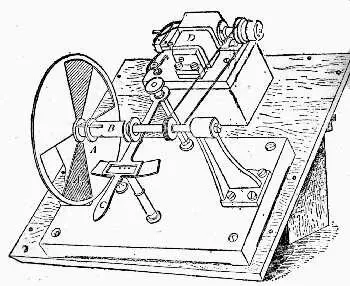
Fig. 7. – Rotating Sectors.
The annexed figure (Fig. 7) is a bird's-eye view of the instrument. A A are two sectors, one of which is capable of closing the open aperture by means of a lever arrangement C, which moves a sleeve in which is fixed a pin working in a screw groove, which allows the aperture in the sectors to be opened and closed at pleasure during their revolution; D is an electro-motor causing the sectors to rotate. To show its efficiency, if two strips of paper, one coated with lamp-black and the other white, are placed side by side on the screen, and if one shadow from the rod falls on the white strip, and the other shadow on the black strip of paper, and the rotating sectors are interposed in the path of the light illuminating the shadow cast on the white strip, the aperture of the sectors can be closed till the white paper appears absolutely blacker than the black paper. White thus becomes darker than lamp-black, owing to the want of illumination. This is an interesting experiment, and we shall see its bearings as we proceed, as it indicates that even lamp-black reflects a certain amount of white or other light.
Читать дальшеИнтервал:
Закладка:
Похожие книги на «Colour Measurement and Mixture»
Представляем Вашему вниманию похожие книги на «Colour Measurement and Mixture» списком для выбора. Мы отобрали схожую по названию и смыслу литературу в надежде предоставить читателям больше вариантов отыскать новые, интересные, ещё непрочитанные произведения.
Обсуждение, отзывы о книге «Colour Measurement and Mixture» и просто собственные мнения читателей. Оставьте ваши комментарии, напишите, что Вы думаете о произведении, его смысле или главных героях. Укажите что конкретно понравилось, а что нет, и почему Вы так считаете.
